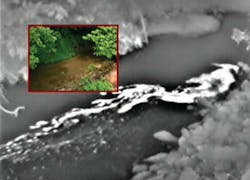Thermal Imaging: Using Thermal Imaging On the Hazmat Call
This month, we get into a tactical discussion on a topic that frequently arises as a discussion item. For many departments, the idea of using thermal imagers (TIs) at hazardous material calls is not often apparent and not well understood. However, with preparation and practice, fire departments can make effective use of TIs at these critical incidents.
Not all departments are equipped or trained to respond to a hazmat call. Those who are equipped to respond have found that a TI is an invaluable tool in their arsenal to effectively and efficiently respond to a hazmat incident. Over the years, more departments have tackled the task of equipping their departments with the tools and training needed to respond to a hazmat call.
How the TI can help
Whether you are responding to a service station fire, chemical plant emergency, overturned tanker truck, derailed train cars or a meth lab fire, hazardous materials are all around us. Having the ability to see the content level of an enclosed container at a safe distance is critical to the safety of the mission. Tracing a spill on the roadway in a rain storm is an environmental necessity. Seeing the gases of a container at a safe distance is common sense.
All of these tasks and more can be performed with a TI. Let’s take a look at a few hazmat situations and learn how a TI could be helpful.
• Use a TI to help locate and track spills of solid and liquid materials. If the spilled material is a different temperature than the ground or water on which it is spilled and the material stays on the surface, it should be visible to your TI. This can help you locate a spill, track its source and determine the extent of contamination (see Photo 1).
• A TI will help only with liquid and solid hazardous materials. These materials may differ in temperature from the container and the vapor space inside the container. Under the correct conditions, temperature differences enable a TI to help indicate a product level. Some TIs provide color overlays that further help distinguish product levels from the vapor space (see Photo 2).
• Pressurized gases will not show a product level in a container. However, gases escaping a pressurized system cause an endothermic reaction, potentially making the area of escape colder than the rest of the system. During a search for a gas leak, looking for a cold section in the containment system could help you locate the primary location of the leak.
• The interior of the TI is not hermetically sealed, so decontamination efforts will not reach the interior of the TI. If this is a concern, you may be able to seal the TI in a clear plastic bag (polyethylene seems to work best) to protect it from the hazardous material and make decontamination easier.
• Safety is always paramount, so don’t overlook the basics. While some TIs have a certain level of certification for use in hazardous locations, most do not. If the hazmat team is concerned about explosive limits, the TI should probably not enter the hot zone.
While a TI does not help you remove the hazardous materials at an incident, it can help you locate and isolate the materials. Two of the most common hazmat applications for using a TI are tracking product spills and identifying product levels in containers.
You can practice using a TI to identify materials while at the firehouse. Try this: Pour non-toxic materials on the floor or in a sink filled with water. Have firefighters use the TI to locate and track the material. You can fill empty containers or use partially full containers from around the station to practice determining product levels. As you examine items in the firehouse, you should notice that sometimes you cannot determine a product level. This is not because there is no product, but because there is no temperature difference on the container surface for the TI to detect.
On a hazmat call, distance is your friend. Knowing in advance and at a distance the possibility of a threat is crucial to the safety of your team and the mitigation task at hand. Higher-resolution models that offer digital zoom capability can help you assess threats from a distance so you can be better prepared for what you are facing. Also, features that identify or colorize the hottest elements on the display can also be beneficial to discern threats or items of interest.
Hazmat incidents are not frequent, but they can pose great challenges. The aggressive use of a TI at a hazmat scene may give the incident commander additional information to make timely and effective decisions. Thermal imaging is quickly becoming a necessity in the tool chest of the modern-day hazmat team.
A special thanks goes out to several of my work colleagues, many of whom are firefighters, for their assistance in researching this topic and preparing this column (and previous others as well). As always, please send me your ideas for future columns.
JOHN HAYS is the Product Line Manager for Emergency Responders at Bullard. He has spent more than 13 years developing emergency responder products for the fire, rescue and police markets. Hays’ technical expertise in developing emergency responder products has been instrumental in advancing the use of thermal imagers in the fire service. If you have questions about thermal imaging, you can email him at [email protected].
About the Author

John Hays
JOHN HAYS is the Product Line Manager for Emergency Responders at Bullard. He has spent more than 13 years developing emergency responder products for the fire, rescue and police markets. Hays’ technical expertise in developing emergency responder products has been instrumental in advancing the use of thermal imagers in the fire service. If you have questions about thermal imaging, you can email him at [email protected].
